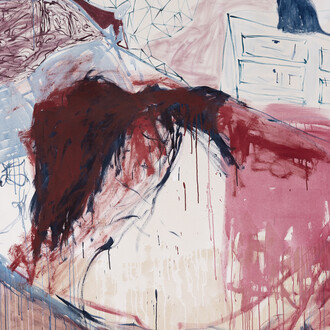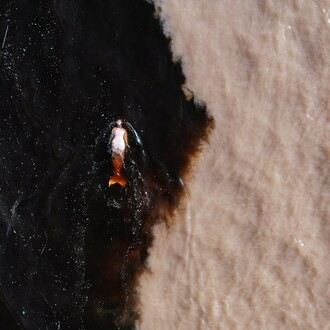Alien shores explores landscape as a place of memory, imagination, yearning and belonging. Through painting, video, photography and sculpture, the artists included offer speculative, symbolic or surreal depictions of emotional terrain and voyages of the imagination, visions of the distant past or possible futures. These are landscapes once removed: shaped by temporal or cultural distance, filtered through technology, mythology or abstraction. Here, the ground shifts beneath our feet and horizons stretch beyond our grasp; natural forms are reduced to geometry; matter defies its nature, as rock flows like water and earth dissolves into mist; forests glow in radioactive hues, sprouting impossible growths, while scenes rendered with photographic clarity nonetheless signal that they are not of this place or time.
In every depiction of landscape is a reflection of the values and beliefs of the society that created it. The tamed abundance of Roman frescoes projects control and luxury; 17th-century Dutch artists of the Golden Age, during which the genre ‘landschap’ was first named, turned away from religious subjects as an expression of Protestant values; Romantic painters, by contrast, imbued nature with the sublime in reaction against the scientific rationalism of the Enlightenment, while in 19th-century America, scenes of awe-inspiring vastness embodied the manifest destiny of a developing national identity. Whilst landscape ranked low in the hierarchy of Western art, at least until the 19th century, shan shui hua (translated literally, ‘mountain water painting’), rooted in philosophical and spiritual traditions, was esteemed in China for over a millennium, and sought less to depict nature than to embody qualities valued in an individual or regime, such as permanence and harmony. Many of the artists included in ‘Alien Shores’ tangle with these historical and transcultural forerunners, operating at a remove, by genre and generation, from nature.
Surveying the genre of landscape today, we might diagnose a crisis of connection. As urbanised, digitised beings confronting an ecological catastrophe of our own making, our relationship to the natural world is increasingly characterised by alienation, nostalgia and anxiety. French philosopher Augustin Berque traces blame for our depredation of nature to what he terms ‘landscape thinking’: that is, the shift in human perception that gave rise to the genre of landscape, a moment when nature was no longer inhabited but represented. Landscape is not the world, but the world through human eyes, shaped by culture, memory and ideology. In an age of simulation and hyperreality, mediated images of nature increasingly supplant lived experience, and the wild becomes a digital backdrop; idealised, commodified. This estrangement is reflected in the aesthetic strategies throughout the works of ‘Alien Shores’, whereby nature is made strange – held at a distance, whether formally, metaphorically or literally.
Alongside this runs a counter-current of yearning, a desire to reconnect with a world that has grown remote, even unrecognisable, and an unsimulated and enduring joy in nature. The persistent tug of landscape on the artistic imagination reflects the fact that our estrangement is recent, and not absolute. For most of human history, the land was not a backdrop but a condition of life. The concept of separateness – from land, from ecology, from place – is a product of modernity, and for many across the world, especially in the Global South, it remains a false one. Landscape as a genre is deeply implicated in a justification of colonial possession, critiqued by art historian W. J. T. Mitchell as the ‘“dreamwork” of imperialism’. In the face of displacement, migration, exile, or simply the mobile nature of contemporary life, a different sense of belonging emerges: one rooted not in specific geography but in attachment to the forms of nature and cultural traditions through which place is felt and expressed. In this context, landscape becomes a symbolic and emotional terrain through which personal, cultural and ancestral narratives are negotiated and shared.
No humans appear in these works, yet in our very absence the question of our relationship to the land is ever-present. These alien shores are our home – reflections of our anxieties, histories and dreams. The exhibition’s title is borrowed from the Latin poet Petronius, who exhorts his reader to ‘seek out alien shores [...] he who disembarks on distant sands, becomes thereby the greater man’. In reaching for new forms of landscape, artists grapple with a way to make sense of where we are, how we got here, and where we might go next.
Exhibiting artists: Etel Adnan, Alia Ahmad, Darren Almond, Harold Ancart, Michael Armitage, Milton Avery, Sholto Blissett, Glenn Brown, Lynne Drexler, Pranay Dutta, Fernanda Galvão, Noémie Goudal, David Hockney, Sky Hopinka, Shara Hughes, Marguerite Humeau, Hung Fai, Eva Jospin, Anselm Kiefer, Richard Mayhew, Ken Gun Min, Joan Nelson, Isamu Noguchi, Minoru Nomata, Georgia O’Keeffe, Bagus Pandega and Kei Imazu, Emilio Perez, Marina Rheingantz, Cinga Samson, Tomás Sánchez, Emma Webster, Takako Yamaguchi, Alyina Zaidi and Robert Zehnder.
















